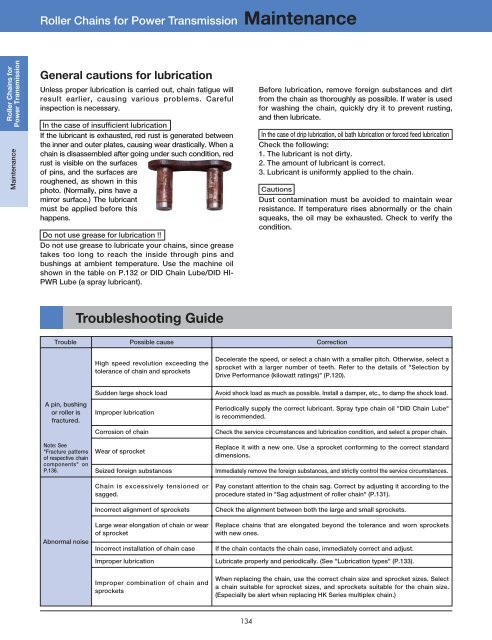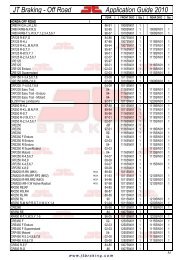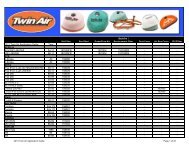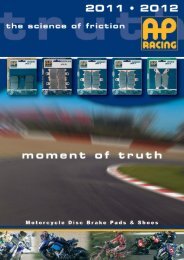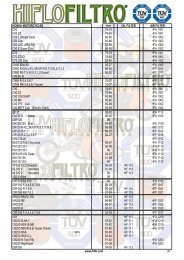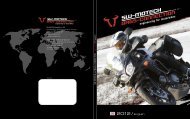DID 60 standard roller chain - Big Bike Webshop
DID 60 standard roller chain - Big Bike Webshop
DID 60 standard roller chain - Big Bike Webshop
You also want an ePaper? Increase the reach of your titles
YUMPU automatically turns print PDFs into web optimized ePapers that Google loves.
Roller Chains for Power Transmission Maintenance<br />
Roller Chains for<br />
Power Transmission<br />
Maintenance<br />
General cautions for lubrication<br />
Unless proper lubrication is carried out, <strong>chain</strong> fatigue will<br />
result earlier, causing various problems. Careful<br />
inspection is necessary.<br />
In the case of insufficient lubrication<br />
If the lubricant is exhausted, red rust is generated between<br />
the inner and outer plates, causing wear drastically. When a<br />
<strong>chain</strong> is disassembled after going under such condition, red<br />
rust is visible on the surfaces<br />
of pins, and the surfaces are<br />
roughened, as shown in this<br />
photo. (Normally, pins have a<br />
mirror surface.) The lubricant<br />
must be applied before this<br />
happens.<br />
Do not use grease for lubrication !!<br />
Do not use grease to lubricate your <strong>chain</strong>s, since grease<br />
takes too long to reach the inside through pins and<br />
bushings at ambient temperature. Use the machine oil<br />
shown in the table on P.132 or <strong>DID</strong> Chain Lube/<strong>DID</strong> HI-<br />
PWR Lube (a spray lubricant).<br />
Before lubrication, remove foreign substances and dirt<br />
from the <strong>chain</strong> as thoroughly as possible. If water is used<br />
for washing the <strong>chain</strong>, quickly dry it to prevent rusting,<br />
and then lubricate.<br />
In the case of drip lubrication, oil bath lubrication or forced feed lubrication<br />
Check the following:<br />
1. The lubricant is not dirty.<br />
2. The amount of lubricant is correct.<br />
3. Lubricant is uniformly applied to the <strong>chain</strong>.<br />
Cautions<br />
Dust contamination must be avoided to maintain wear<br />
resistance. If temperature rises abnormally or the <strong>chain</strong><br />
squeaks, the oil may be exhausted. Check to verify the<br />
condition.<br />
Troubleshooting Guide<br />
Trouble<br />
A pin, bushing<br />
or <strong>roller</strong> is<br />
fractured.<br />
Note: See<br />
"Fracture patterns<br />
of respective <strong>chain</strong><br />
components" on<br />
P.136.<br />
Abnormal noise<br />
Possible cause<br />
High speed revolution exceeding the<br />
tolerance of <strong>chain</strong> and sprockets<br />
Sudden large shock load<br />
Improper lubrication<br />
Corrosion of <strong>chain</strong><br />
Wear of sprocket<br />
Seized foreign substances<br />
Chain is excessively tensioned or<br />
sagged.<br />
Incorrect alignment of sprockets<br />
Large wear elongation of <strong>chain</strong> or wear<br />
of sprocket<br />
Incorrect installation of <strong>chain</strong> case<br />
Improper lubrication<br />
Improper combination of <strong>chain</strong> and<br />
sprockets<br />
Correction<br />
Decelerate the speed, or select a <strong>chain</strong> with a smaller pitch. Otherwise, select a<br />
sprocket with a larger number of teeth. Refer to the details of "Selection by<br />
Drive Performance (kilowatt ratings)" (P.120).<br />
Avoid shock load as much as possible. Install a damper, etc., to damp the shock load.<br />
Periodically supply the correct lubricant. Spray type <strong>chain</strong> oil "<strong>DID</strong> Chain Lube"<br />
is recommended.<br />
Check the service circumstances and lubrication condition, and select a proper <strong>chain</strong>.<br />
Replace it with a new one. Use a sprocket conforming to the correct <strong>standard</strong><br />
dimensions.<br />
Immediately remove the foreign substances, and strictly control the service circumstances.<br />
Pay constant attention to the <strong>chain</strong> sag. Correct by adjusting it according to the<br />
procedure stated in "Sag adjustment of <strong>roller</strong> <strong>chain</strong>" (P.131).<br />
Check the alignment between both the large and small sprockets.<br />
Replace <strong>chain</strong>s that are elongated beyond the tolerance and worn sprockets<br />
with new ones.<br />
If the <strong>chain</strong> contacts the <strong>chain</strong> case, immediately correct and adjust.<br />
Lubricate properly and periodically. (See "Lubrication types" (P.133).<br />
When replacing the <strong>chain</strong>, use the correct <strong>chain</strong> size and sprocket sizes. Select<br />
a <strong>chain</strong> suitable for sprocket sizes, and sprockets suitable for the <strong>chain</strong> size.<br />
(Especially be alert when replacing HK Series multiplex <strong>chain</strong>.)<br />
134


